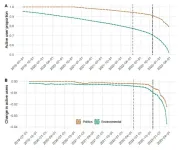(Press-News.org) Russia’s attack on Ukraine has resulted in one of the largest movements of refugees since the Second World War. More than 7.4 million Ukrainians have sought asylum in Europe, almost three times the number of people who found refuge in Europe during Syria’s civil war in 2015 and 2016.
To investigate whether and how the willingness of host populations to receive refugees has changed since 2016, an international research team involving ETH Zurich, the University of California, Berkeley, and Stanford University surveyed 33,000 people in 15 European countries. The first wave of the survey took place in February 2016 and the second from May to June 2022. The researchers showed respondents profiles of hypothetical asylum seekers, with randomly varied characteristics such as religion, gender, occupation, or reason for fleeing. The respondents then decided which asylum-seeker profiles they would accept to host in their country. The study will be published in the journal Nature.
Ukrainian refugees are more popular
The research confirms that attitudes towards Ukrainian refugees are more positive than they are towards refugees from countries such as Syria, Pakistan, and Afghanistan. The reason for this, however, has less to do with nationality per se, and more with the fact that Ukrainian refugees exhibit a number of characteristics favoured by the European public. “Respondents are more in favour of accepting asylum seekers who are younger, female, Christian rather than Muslim, submit consistent asylum applications, possess better language and occupational skills, and who are in particular need of protection,” explains Dominik Hangartner, professor of public policy at ETH Zurich. Refugees from Ukraine are more likely to possess these attributes than asylum seekers from other countries.
In line with the Geneva Convention on Refugees, the reason for seeking refuge also plays a significant role in the willingness of European societies to accept asylum seekers. Respondents are more likely to feel a sense of solidarity with people fleeing war and political and religious persecution. Asylum seekers leaving their home country for economic reasons are viewed with much greater scepticism (see figure 1 and 2).
Willingness to accept refugees remains stable
The researchers’ analysis also reveals that people’s willingness to accept refugees in Europe has remained surprisingly stable, even after the second large-scale movement of refugees in the last eight years. “We see no indication of solidarity towards refugees declining. In fact, the opposite is true: support is slightly higher now than at the height of the Syrian refugee crisis,” says Hangartner. This is even more surprising since existing research suggests that scepticism towards refugees tends to increase during periods of economic pressure and high inflation (see figure 3).
Compared to the rest of Europe, Switzerland occupies a mid-table position, with respondents willing to accept 49 percent of the hypothetical asylum seekers. It ranks below countries such as Spain (60 percent) and Italy (58 percent), but above countries like the Czech Republic (38 percent) and Hungary (47 percent).
Solidarity with Ukraine doesn’t come at the expense of other groups
The study’s findings also refute concerns that solidarity with Ukrainian refugees would inevitably come at the expense of support for other groups. As Hangartner explains: “The number of non-Ukrainian asylum seekers whom our respondents would take in has either remained the same or increased compared to 2016.”
This also holds true for Muslim refugees; while Europeans are generally more willing to accept refugees who are Christian, this has not translated into a decrease in support for Muslim asylum seekers since 2016. On the contrary, support has actually risen for Muslim asylum seekers in most countries (see figure 4).
Support for refugees also increasing among the centre right
The researchers also examined the extent to which the willingness to accept refugees correlates with the political views of the respondents. As expected, people who identify as being left-wing are more willing to accept greater numbers of refugees than those who define themselves as being more right-wing (see figure 5).
Respondents in Switzerland who identify as being more left-wing were willing to accept 65 percent of the refugee profiles presented to them by the researchers in 2022. In Germany, the figure was 66 percent, in Austria 63 percent. Respondents who define themselves as being more to the right of centre are markedly more restrictive: in Switzerland this group was willing to accept 35 percent of the refugees, in Austria 38 percent and in Germany 42 percent. Notwithstanding these differences, support for refugees increased between 2016 and 2022 among both left-wing (by 6 percent) and right-wing (by 4 percent) respondents across Europe. In fact, in Switzerland, support increased by a slightly greater margin among right-wing respondents than left-wing respondents. Based on this evidence, the researchers conclude that in terms of willingness to accept refugees, there has been no apparent increase in polarisation.
END
Favored asylum seekers are young, female and fleeing war
2023-08-15
ELSE PRESS RELEASES FROM THIS DATE:
More than 800 human-harvested shellfish species tend to be more resistant to extinction
2023-08-15
In a new study, scientists Stewart Edie of the Smithsonian, Shan Huang of the University of Birmingham and colleagues drastically expanded the list of bivalve species, such as clams, oysters, mussels, scallops and their relatives, that humans are known to harvest and identified the traits that make these species prime targets for harvesting. They also discovered that some of these same traits have also made this group of shellfish less prone to extinction in the past and may protect these shellfish in the future. The authors flagged certain ocean regions, such as the east Atlantic and northeast and southeast Pacific, as areas of special concern for management and conservation.
The ...
Nearly 50% of environmentalists abandoned Twitter following Musk’s takeover
2023-08-15
In October 2022, Elon Musk purchased Twitter (recently renamed X), which had previously served as the leading social media platform for environmental discourse. Since then, reports a team of researchers in the journal Trends in Ecology and Evolution on August 15, there has been a mass exodus of environmental users on the platform—a phenomenon that could have serious implications for public communication surrounding topics like biodiversity, climate change, and natural disaster recovery.
“Twitter has been the dominant social ...
Reduced grey matter in frontal lobes linked to teenage smoking and nicotine addiction – study
2023-08-15
Levels of grey matter in two parts of the brain may be linked to a desire to start smoking during adolescence and the strengthening of nicotine addiction, a new study has shown.
A team of scientists, led by the universities of Cambridge and Warwick in the UK and Fudan University in China, analysed brain imaging and behavioural data of over 800 young people at the ages of 14, 19 and 23.
They found that, on average, teenagers who started smoking by 14 years of age had markedly less grey matter in a section of the left frontal lobe linked to ...
Infants admitted to ICUs for RSV infection during the 2022 seasonal peak
2023-08-15
About The Study: In this study, most U.S. infants who required intensive care for respiratory syncytial virus (RSV) lower respiratory tract infections were young, healthy, and born at term. These findings highlight the need for RSV preventive interventions targeting all infants to reduce the burden of severe RSV illness.
Authors: Natasha Halasa, M.D., M.P.H., of the Vanderbilt University Medical Center in Nashville, and Angela P. Campbell, M.D., M.P.H., of the Centers for Disease Control and Prevention in Atlanta, are the corresponding authors.
To access the embargoed study: Visit our For The Media website at this ...
Communication of COVID-19 misinformation on social media by physicians in the US
2023-08-15
About The Study: In this study of high-use social media platforms, physicians from across the U.S. and representing a range of medical specialties were found to propagate COVID-19 misinformation about vaccines, treatments, and masks on large social media and other online platforms and that many had a wide reach based on number of followers.
Authors: Sarah L. Goff, M.D., Ph.D., of the University of Massachusetts, Amherst, is the corresponding author.
To access the embargoed study: Visit our For ...
Study explains how part of the nucleolus evolved
2023-08-15
Inside all living cells, loosely formed assemblies known as biomolecular condensates perform many critical functions. However, it is not well understood how proteins and other biomolecules come together to form these assemblies within cells.
MIT biologists have now discovered that a single scaffolding protein is responsible for the formation of one of these condensates, which forms within a cell organelle called the nucleolus. Without this protein, known as TCOF1, this condensate cannot form.
The findings could help to ...
Lundquist Principal Investigator Dr. Michael Yeaman awarded $11.5 million NIAID/HHS grant for innovative research to understand and solve persistent bloodstream infections
2023-08-15
The Lundquist Institute (TLI) at Harbor-UCLA Medical Center announced today that TLI Principal Investigator, Michael Yeaman, PhD, has been awarded a grant totaling $11.5M from the National Institute of Allergy and Infectious Diseases (NIAID), Department of Health & Human Services. Along with his role at TLI, Dr. Yeaman is Professor of Medicine at UCLA, and Chief, Division of Molecular Medicine at Harbor-UCLA Medical Center.
This new NIH U19 Center program will decode patterns of the human immune system and microbial pathogens that result in infections that are not ...
Study finds most infants receiving ICU-level care for RSV had no underlying medical condition
2023-08-15
Most infants admitted to the intensive care or high acuity unit for respiratory syncytial virus (RSV) infections during fall 2022 were previously healthy and born at term, according to a new study reported in JAMA Network Open.
The findings from this study support the use of preventative interventions in all infants to protect them from RSV, the leading cause of lower respiratory tract infections (LRTI) and hospitalizations worldwide.
RSV accounts for about 57,000-80,000 hospitalizations in children younger than 5 years with 1 in 5 RSV-positive hospitalized children being admitted ...
Making sense of life’s random rhythms
2023-08-15
CLEVELAND–Life’s random rhythms surround us–from the hypnotic, synchronized blinking of fireflies…to the back-and-forth motion of a child’s swing… to slight variations in the otherwise steady lub-dub of the human heart.
But truly understanding those rhythms—called stochastic, or random, oscillations—has eluded scientists. While researchers and clinicians have some success in parsing brain waves and heartbeats, they’ve been unable to compare or catalogue an untold number of variations and sources.
Gaining such insight into the underlying ...
Robotic exoskeletons and neurorehabilitation for acquired brain injury: Determining the potential for recovery of overground walking
2023-08-15
East Hanover, NJ. August 15, 2023. A team of New Jersey researchers reviewed the evidence for the impact of robotic exoskeleton devices on recovery of ambulation among individua5ls with acquired brain injury, laying out a systematic framework for the evaluation of such devices that is needed for rigorous research studies. The open access article, "Lower extremity robotic exoskeleton devices for overground ambulation recovery in acquired brain injury – A review” (doi: 10.3389/fnbot.2023/1014616), was published ...





